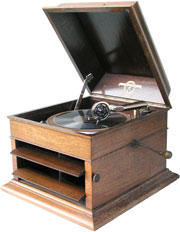
|
Deutscher Text Mit dem elektrischen Aufnahmeverfahren kam 1925 ein neues System auf den Markt, welches die Sprechmaschinen-Industrie revolutionierte. Der Frequenzgang der Aufnahmen wurde damit massiv erweitert. Endlich konnte man alle Instrumente eines Sinfonieorchesters deutlich hören und die Wiedergabe zeichnete sich durch eine nie da gewesene Dynamik aus. Zudem wurden viele lästige Nebengeräusche eliminiert. Mit dem neuen Aufnahmeverfahren wurden aber auch die Standards der Tonrille neu definiert, was dazu führte, dass die neuen Schallplatten auf alten Grammophonen nicht das gewünschte Resultat brachten. Denn wollte man die bessere Klanqualität auch nutzen, brauchte man dazu ein neues Abspielgerät. Es ist wahrscheinlich, dass grosse Firmen wie Victor und Columbia absichtlich Platten auf den Markt brachten, die auf den älteren Grammophon-Modellen schlecht und verzerrt tönten. Man erhoffte sich damit, den Verkauf der neuen Geräte anzukurbeln, deren Schalldosen und Tonarme so gebaut wurden, dass alle klanglichen Vorteile des neue Plattenformats hörbar wurden. Victor bezeichnete diese Grammophone mit "Ortophonic" und Columbia mit "Viva-tonal". Der Columbia "Grafonola" wurde ab 1925 hergestellt. Das
elegante, in den 1920er und 1930er Jahren sehr beliebte Tischmodell
trägt die Bezeichnung "Viva-tonal" und tönt
wirklich ausgezeichnet. In seiner Front hat es zwei Jalousien, mit
denen man je nach Öffnung die Lautstärke regulieren kann.
Das Gerät ist mit der Schalldose "Columbia No.9"
ausgerüstet und trägt die Serien-Nummer 119a. Speziell
ist der abgewinkelte Tonarm, welcher die Tonqualität positiv
beeinflussen sollen. Der Tonkanal endet gabelförmig in zwei,
im Gehäuse integrierten Metall-Trichtern. Auf diese Weise sollte
eine räumliche Klangwirkung entstehen. |
English Text In 1925 the electrical recording system was introduced, what became a heavy revolution for the talking machine industry. This new systems allows larger frequency by recording, the instruments of a symphony orchestra cut be heard now clear and the reproducing was distinguished by wide dynamics. Moreover, a lot of troublesome noses cut be eliminated. But with this new recording system, also standards for the grooves are new defined. Many buyers of records was astounded at the cacophony that ensued when they played this well praised records on there old talking machines at home. To use the full range of the higher quality, new gramophones ar needed. Maybe it was a marketing strategy, making records witch would not play acceptably on older machines, but witch could be reproduced with an astounding improvement. It was the policy to make all existing gramophones obsolete. New talking machines came on the market. There sound boxes and tone arms are designed to play the new electrical records with the full range of all advantages. Victor cold them "Ortophonic" and Columbia "Viva-tonal". The model "Grafonola" by Columbia was produced since
1925. This elegant table gramophone was very popular during the
late 1920’s and the 1930’s. It is stamped by the mark
"Viva-tonal" and the serial number 119a. Loudness can
be regulated by more or less opening of two window shades in the
front. Characteristic is the special angled tone arm. This gramophone
is fitted by the sound box Columbia No.2. There are two separated
metallic horns inside the case who should produce something like
stereo sound and giving the illusion of space. |